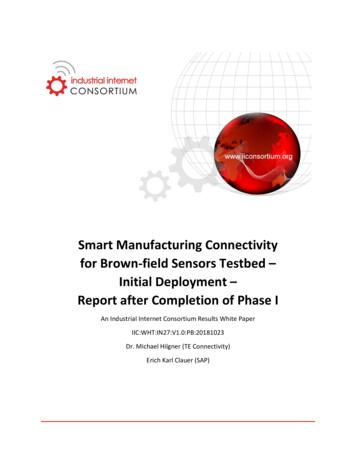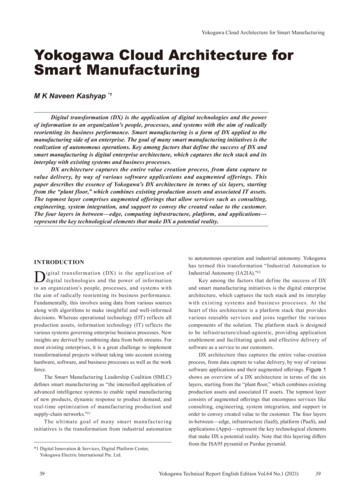
Transcription
Smart Manufacturing Connectivityfor Brown-field Sensors Testbed –Initial Deployment –Report after Completion of Phase IAn Industrial Internet Consortium Results White PaperIIC:WHT:IN27:V1.0:PB:20181023Dr. Michael Hilgner (TE Connectivity)Erich Karl Clauer (SAP)
Smart Manufacturing Connectivity for Brown-field Sensors Testbed – Completion of Phase IThis white paper provides an overview of the accomplishments of phase I of the “Smart Manufacturing Connectivity for Brown-field Sensors Testbed.” The testbed addresses the discretemanufacturing domain where Programmable Logic Controllers (PLCs) typically govern localcontrol loops of sensors and actuators that are either directly connected to a PLC or via anInput/Output module, an I/O module. The testbed focuses on a brown-field scenario where IOLink sensors are connected to an elderly PLC through an IO-Link master gateway, which is aspecial active I/O module capable of mastering IO-Link devices. IO-Link is a digital interface thatenables a bidirectional data exchange with sensors and actuators.The testbed comprises the development of a retrofittable hardware that is intended to replacean existing I/O module and establishes a communication channel towards higher-level ITsystems, in addition to the channel used for the data exchange with the PLC. As this hardwaredelivers data from a common source, namely a set of sensors, to two recipients, the higherlevel IT system and the PLC, it is called the “Y-Gateway.” The data exchanged through the twocommunication paths are however quite different: The PLC is only provided with the datarequired to run the original control task, whereas more comprehensive information is deliveredthrough the additional path to enable added value services. So, the (elderly) PLC is notburdened with data processing beyond carrying out the functions for which it was onceselected and programmed.The testbed further encompasses the definition and implementation of a consistent mappingfrom IO-Link to OPC Unified Architecture (OPC UA). The result is an OPC UA device model withstandardized semantics that is used by the server-client-based data exchange between the YGateway and the IT system to facilitate the easy integration of the sensor data within the ITsystem’s data base. Using OPC UA over TCP/IP for the additional channel established by the YGateway not only guarantees the semantic interoperability but also assures a secureconnection through OPC UA’s proven security mechanisms.The testbed finally includes the implementation of a usage scenario that increases the overallequipment effectiveness of a manufacturing process step by collecting data on consumedresources by a set of IO-Link sensors and providing those to SAP Manufacturing Integration &Intelligence (SAP MII) or SAP Cloud via the additional communication path that allows for theimplementation of added value service at the enterprise level.The white paper describes the proposed solutions’ elements and fundamental capabilities andthe technical details have been made available to the Industrial Internet Consortium (IIC)community via more comprehensive deliverables, such as a high-level description of the IOLink/OPC UA mapping, a report on the Y-Gateway’s endpoint security threat analysis, aspecification to measure the latency of the real-time path through the Y-Gateway, a descriptionof OPC UA’s communication security mechanisms and a report on the impact of applyingsecurity measures on OPC UA’s performance.IIC:WHT:IN27:V1.0:PB:20181023-2-
Smart Manufacturing Connectivity for Brown-field Sensors Testbed – Completion of Phase IThis set of deliverables, including this white paper, documents the technical feasibility of thetestbed’s approach and shows the benefits for manufacturing operators, namely thatretrofitting a brown-field facility with just a few sensors and connecting them to theappropriate platform solution provides quick insights into potential improvements andoptimization requirements.INTRODUCTION INTO THE TESTBEDThe Smart Manufacturing Connectivity for Brown-field Sensors Testbed is a joint effort of IICmembers TE Connectivity, a world leader in connectivity and sensors, and SAP, a world leader inenterprise applications in terms of software and software-related service revenue. Additionalcollaboration partners are ifm, a worldwide leader in sensors, controllers and systems forautomation and the OPC Foundation, the organization defining the industrial interoperabilitystandard OPC UA. The IIC Steering Committee approved the testbed in April 2016. Publicinformation is available on a dedicated web page under www.iiconsortium.org.This testbed addresses the discrete manufacturing domain, traditionally characterized by astrict hierarchical structure, referred to as the “Automation Pyramid.” At the control level of thepyramid, PLCs manage the real-time sub-systems, including sensors and actuators, and providethe connection to the enterprise IT systems. In this structure, any data generated by a sensorpasses through the PLC. Whereas planning a green-field installation generally considers thecapability of processing a high volume of data required by advanced (cloud-based) analytics forthe selection of the PLCs, in brown-field facilities, the PLCs are often capable of running theautomation sequence only.IIC:WHT:IN27:V1.0:PB:20181023-3-
Smart Manufacturing Connectivity for Brown-field Sensors Testbed – Completion of Phase IFigure 1: Traditional Automation Pyramid and additional communication path (“IoT data flow”) asproposed by the testbedThe testbed extracts data from the real-time control system and delivers it to the higher-level ITsystems via an additional communication path without affecting real-time operations. Thissolution comprises the following elements: Retrofittable hardware, the “Y-Gateway,” with IO-Link, Industrial Ethernet and OPC UA(TCP/IP) interfaces, that re-uses existing cabling.The definition and standardization of a common device model to allow for the easyintegration with the IT system. This device model is based on the consistent mapping ofIO-Link parameters to OPC UA.An IT platform that maintains the individual devices’ configurations and aggregatesprocess data to enable the implementation of applications.The following sections provide more details on these elements and an example of how thesolution can be used to monitor the resource efficiency of a manufacturing process.Y-GATEWAYThe Y-Gateway replaces a common I/O module. It has an interface to exchange data with theconnected IO-Link devices via OPC UA over TCP/IP, in addition to the interface to the industrialcommunication system, e.g., an Industrial Ethernet such as PROFINET, Ethernet/IP or EtherCAT.That data is extracted from a memory block used by the IO-Link master implementation andIIC:WHT:IN27:V1.0:PB:20181023-4-
Smart Manufacturing Connectivity for Brown-field Sensors Testbed – Completion of Phase Iconverted to OPC UA semantics in a separate processing unit on the Y-Gateway. This ensuresthat real-time operations are not significantly delayed, as proven by dedicated latencymeasurements. Figure 2 provides an overview of contributions to the overall system latency Ttalong the real-time path which is given by the sum Tt TS1 TS2 TS3 where: TS1 is the duration from an event at the input of the sensor to the transmission of therespective message over the IO-Link channel,TS2 is the latency in the I/O module or Y-Gateway, respectively, due to requiredconversion steps between the IO-Link master input and the Industrial Ethernet outputandTS3 is the conversion time from the PLC’s input to its digital output.TS2 can be further broken down into time intervals used by the IO-Link master stack for sampling (TIS) and processing (TIP),the time TC taken by the required conversions andthe processing time TIE taken by the Industrial Ethernet software stack.Figure 2: Contributions to the overall system latency of the real-time pathTC is the interval of interest here. In the case of the original I/O module, TC refers to theconversion to the Industrial Ethernet frames only, whereas for the Y-Gateway, TC is dominatedby the time required for the IO-Link/OPC UA conversion. With the assumptions of TS3 TS1 andTS3 TS2 and measurements for reduced setups, TC can be determined for both cases. Ameasurement specification made available to the IIC members provides further details here.The Y-Gateway can connect up to eight IO-Link sensors or actuators. It is delivered with aconfiguration tool that provides an overview on the connected devices and enables theassociation of process data with custom variables. The Y-Gateway also enables data preparationIIC:WHT:IN27:V1.0:PB:20181023-5-
Smart Manufacturing Connectivity for Brown-field Sensors Testbed – Completion of Phase Iand combination of data from several IO-Link sensors prior to the delivery to the connected ITsystem.IO-LINKThe IO-Link technology provides a serial, bi-directional, point-to-point interface for theconnection of sensors and actuators to a control system, including a 24V power supply. There isa set of IO-Link specifications published by the IO-Link Community. The fundamental IO-Linkspecification is adopted as International Standard IEC 61131-9 (Programmable controllers—Part9: Single-drop digital communication interface for small sensors and actuators (SDCI)) andhence allows consistent integration with common industrial communication and automationsystems.IO-Link is developed and promoted by the IO-Link Community (www.io-link.com). Testbedpartners TE Connectivity and ifm are members of that community. The IO-Link SystemDescription made available on www.io-link.com/en/Download/Download provides an overviewof the technology. An IO-Link system consists of the following basic components: IO-Link devices (e.g., sensors, RFID readers, valves, motor starters and IO modules),an IO-Link master that establishes the connection between the IO-Link devices and theautomation system, where one IO-Link device is connected to one port of the master(point-to-point) andunshielded (3- or 5-conductor) cables of up to 20 m to connect the devices and themaster.According to the IO-Link Specification v1.1, IO-Link supports the modes with transmission ratesof 230.4, 38.4 and 4.8 kbaud. The response time of the system depends on the cycle times ofthe devices. The minimum cycle time is specified for each device in the respective devicedescription (the IO Device Description or IODD).Four types of data are communicated via an IO-Link Interface: (cyclic) process data with a maximum of 32 bytes,(cyclic) status data indicating the integrity of the process data (mostly transmittedtogether with the process data),(acyclic) device data providing parameters, identification or diagnostic information on adevice at the request of the IO-Link master and(acyclic) events, such as error messages and maintenance warnings (e.g., in case ofoverheating).IIC:WHT:IN27:V1.0:PB:20181023-6-
Smart Manufacturing Connectivity for Brown-field Sensors Testbed – Completion of Phase IDedicated tools provided by the IO-Link master suppliers are used for configuration purposes.Each IO-Link device is delivered with a set of configuration files with the device’s IODD. Theconfiguration tool is fed with the IODDs of the connected devices and may then be used to: assign the devices to the ports of the master,map IO addresses of the individual ports’ process data to master addresses andassign parameters of the IO-Link devices.The IODD is an electronic device description available for each IO-Link device and contains avariety of information for the system integration. The structure of the IODD is based on anInternational Standard (ISO 15745-1 Industrial automation systems and integration—Opensystems application integration framework—Part 1: Generic reference description) and is thusidentical for all devices of all manufacturers.The IODD is explained in detail in the IO Device Description Specification that is also availablefrom www.io-link.com/en/Download/Download together with the IODD Checker tool that maybe used to verify the integrity of an IODD.The properties of a device are specified within the following XML files: the main IODD file contains information about the identification of the device,communication characteristics, parameters, process data and diagnosis data andthe standard definition files contain the definition of standardized variables, error typesand events as well as the definitions of all available unit codes.OPC UNIFIED ARCHITECTUREOPC UA, also published as IEC 62541, allows for the exchange of information models of anycomplexity—both instances and types (metadata)—and so enables semantic interoperability.OPC UA is designed to support a wide range of systems, ranging from PLCs in production toenterprise servers. These systems are characterized by their diversity in terms of size,performance, platforms and functional capabilities.The following functionalities were specified for OPC UA, forming the basis of the OPC UAinformation-modeling framework:Transport for the data exchange mechanisms between OPC UA applications. Different transportprotocols exist for different requirements.The metamodel specifies the rules and basic components for publishing an information modelvia OPC UA. It also includes various basic nodes and basic types.Services constitute the interface between a server as information provider and clients asconsumer of this information. OPC UA defines the services required to navigate through theaddress space, read or write variables and subscribing for data modifications and events.IIC:WHT:IN27:V1.0:PB:20181023-7-
Smart Manufacturing Connectivity for Brown-field Sensors Testbed – Completion of Phase IService requests and responses are transmitted through exchange of messages between clientsand servers.Information models are layers on top of these basic functions where each high-order typeconforms with the basic rules. There are already some generic models specified by OPC UA(Data Access, Alarms and Conditions, Historical Access and Programs), which may also serve asa basis to derive additional, more specialized information models.Figure 3: OPC UA information modeling frameworkThe OPC UA address-space model enables production data, alarms, events and historic data tobe integrated in a single OPC UA server. It integrates and standardizes the different addressspaces and services, so that OPC UA applications only require a single interface for navigation,for example, representing a temperature-measuring device as an object with its temperaturevalue, alarm parameters and corresponding alarm limits.The OPC UA address space is structured hierarchically to support the interoperability of clientsand servers. The top level is standardized and thus identical for all servers. All nodes in theaddress space can be reached by descending the hierarchy. Even clients that implement thebasic rules only can process complex information models and navigate through the addressspace and read or write data variables.Security is a fundamental requirement for OPC UA and is integrated in the architecture. Themechanisms are based on a detailed analysis of the threats. OPC UA security deals with theauthentication of clients and servers, the integrity and confidentiality of the exchangedmessages and the verifiability of functional profiles.MAPPING FROM IO-LINK TO OPC UAAny IO-Link device is delivered with a set of XML files that provide the device description (IODD)originally intended for configuration purposes. The contents of these files need to beIIC:WHT:IN27:V1.0:PB:20181023-8-
Smart Manufacturing Connectivity for Brown-field Sensors Testbed – Completion of Phase Istandardized and converted to OPC UA data structures (i.e., specific extensions are added tothe basic OPC UA information models).OPC UA Companion Standards specify OPC UA language extensions for specific data sources.Companion standards for devices are based on IEC 62541-100, which provides a top-leveldevice base-type and an associated event base-type.Figure 4: Examples of OPC UA Companion Standards,OPC UA Companion Standards for devices shall be based on IEC 62541-100The actual mapping from IO-Link to OPC UA comprises the following steps: derive an IO-Link device base-type from the OPC UA device base-type as defined inIEC 62541-100 and use that as a basis for specific types for the individual IO-Link devicecategories such as gateways and sensors, derive an IO-Link event base-type from the device event base-type as defined inIEC 62541-100 and use that as a basis for specific event types associated with thespecific IO-Link device categories, provide a consistent mapping of the IODD data types to OPC UA data types (e.g., TimeT(IODD) into Time (OPC UA), StringT into String, Float32T into Float, etc.), provide a mapping of the IODD data into the OPC UA data, i.e. extract the individualoffset-based IODD data items and assign them to the elements of the OPC UA IO-Linkdevice instances (which may be defined by the base type or a type derived from that)and provide a mapping of the IO-Link events into the OPC UA IO-Link event instances.The definition and implementation of the mapping delivered a valuable starting point for theelaboration of an IO-Link/OPC UA Companion Standard that is currently performed by the IOLink Community together with the OPC UA Foundation. Two joint working groups had beenfounded, both of which are chaired by TE Connectivity: the marketing working group thatdelivered a comprehensive documentation of use cases and requirements in May 2017, and thetechnical working group officially established under IO-Link as “C4/PG51” that has beenIIC:WHT:IN27:V1.0:PB:20181023-9-
Smart Manufacturing Connectivity for Brown-field Sensors Testbed – Completion of Phase Iworking on the specification since June 2016. The final review by the IO-Link Community wasinitiated in September 2018, and it should be published by the end of 2018. With theimplementation of the additions and modifications required to satisfy all requirements of thespecification, the testbed will also serve as a reference implementation, the availability ofwhich is a prerequisite for the adoption by the OPC Foundation.PLATFORM OPTIONSFor communication with the Enterprise or Cloud Platform Level, SAP Plant Connectivity (PCo)serves as an OPC Client. In addition to its role as OPC UA client that is used in this testbed, PCosupports many common communication protocols used for data exchange in IIoT applications(e.g., MQTT). PCo is designed to establish the connection to various platform solutions each ofwhich is suitable for a wide range of applications with diverse focuses.Within this testbed, two platform solutions were connected and associated data models wereimplemented:SAP Manufacturing Integration & Intelligence (MII) is an SAP application forsynchronizing manufacturing operations with back-office business processes. In manyuse cases it is configured as a data hub between SAP ERP and operational applications,such as a manufacturing execution system (MES) and provides analytics and workflowtools for identifying problems in the production process and improving its performance.SAP Cloud Platform is a platform-as-a-service developed by SAP SE for creating newapplications or extending existing applications in a secure cloud computing environmentmanaged by SAP. The SAP Cloud Platform integrates data and business processes.IIC:WHT:IN27:V1.0:PB:20181023- 10 -
Smart Manufacturing Connectivity for Brown-field Sensors Testbed – Completion of Phase IFigure 5: SAP Plant Connectivity can connect devices and control units to SAP MII or SAP CloudUSAGE SCENARIO EXAMPLEThe architecture of the testbed enables the provision of a high volume of sensor data toenterprise IT systems to support decision-making and automation processes through advancedanalytics and machine learning.Overall equipment effectiveness (OEE) is a common key performance indicator inmanufacturing. OEE is the ratio of fully productive time by planned production time and itreflects three factors: availability, performance and quality. Optimizing the use of resources(i.e., raw materials and energy) directly affects OEE and therefore many usage scenarios focuson improving the use of one or more resources.The testbed is applied to a manufacturing case to monitor and optimize the amount ofconsumed compressed air per produced part. This usage scenario is implemented for validationpurposes, however, deals with a common manufacturing challenge at the same time. The setupis rather simple and includes two sensors: an IO-Link compressed air meter (ifm SD6000) to measure precisely the air flow theconsumption and the current temperature andan IO-Link laser distance sensor (ifm O5D100) to count the produced pieces and thus, todetermine the produced volumes.IIC:WHT:IN27:V1.0:PB:20181023- 11 -
Smart Manufacturing Connectivity for Brown-field Sensors Testbed – Completion of Phase IFigure 6: The implemented usage scenario evaluates the ratio of produced piecesby consumed compressed airThe sensors are connected to a Y-Gateway that converts and provides the data via OPC UA toPCo, which then delivers them to either MII or SAP Cloud. Both cases have been implementedfor this testbed however all graphs included in this section were generated within MII.Figures 7 and 8 below show the consumed compressed air per produced part and over time.Thirty-six parts were produced in about eleven minutes.IIC:WHT:IN27:V1.0:PB:20181023- 12 -
Smart Manufacturing Connectivity for Brown-field Sensors Testbed – Completion of Phase IFigure 7: Consumed compressed air per produced partFigure 8: Consumed compressed air over timeThe consumed compressed air significantly varies over the produced parts. This finding is astarting point for a deeper root-cause analysis that can yield increased overall equipmenteffectiveness and thus savings. This variation was likely not obvious to the operator prior to thedeployment of the sensors and monitoring of the data, nor was it the focus of the testbed.Retrofitting a brown-field facility with just a few sensors and connecting them to theappropriate platform solution provided quick—and unexpected—insights into potentialimprovements and optimization requirements. Future implementations within real industryscenarios in phase II will produce further compelling insights and reduce costs.IIC:WHT:IN27:V1.0:PB:20181023- 13 -
Smart Manufacturing Connectivity for Brown-field Sensors Testbed – Completion of Phase IAUTHORS AND LEGAL NOTICEThis document is a work product of the Industrial Internet Consortium Testbed Working Group.It is authored by Dr. Michael Hilgner (TE Connectivity) and Erich Karl Clauer (SAP).Technical Editor: Stephen Mellor (IIC staff) oversaw the process of organizing the contributionsof the above Authors into an integrated document.Copyright 2018 Industrial Internet Consortium, a program of the Object Management Group,Inc. (“OMG”).All copying, distribution and use are subject to the limited License, Permission, Disclaimer andother terms stated in the Industrial Internet Consortium Use of Information – Terms, Conditions& Notices, as posted at http://www.iiconsortium.org/legal/index.htm#use info. If you do notaccept these Terms, you are not permitted to use the document.IIC:WHT:IN27:V1.0:PB:20181023- 14 -
An IO-Link system consists of the following basic components: IO-Link devices (e.g., sensors, RFID readers, valves, motor starters and IO modules), an IO-Link master that establishes the connection between the IO-Link devices and the automation system, where one IO-Link device is connected to one port of the master (point-to-point) and.










